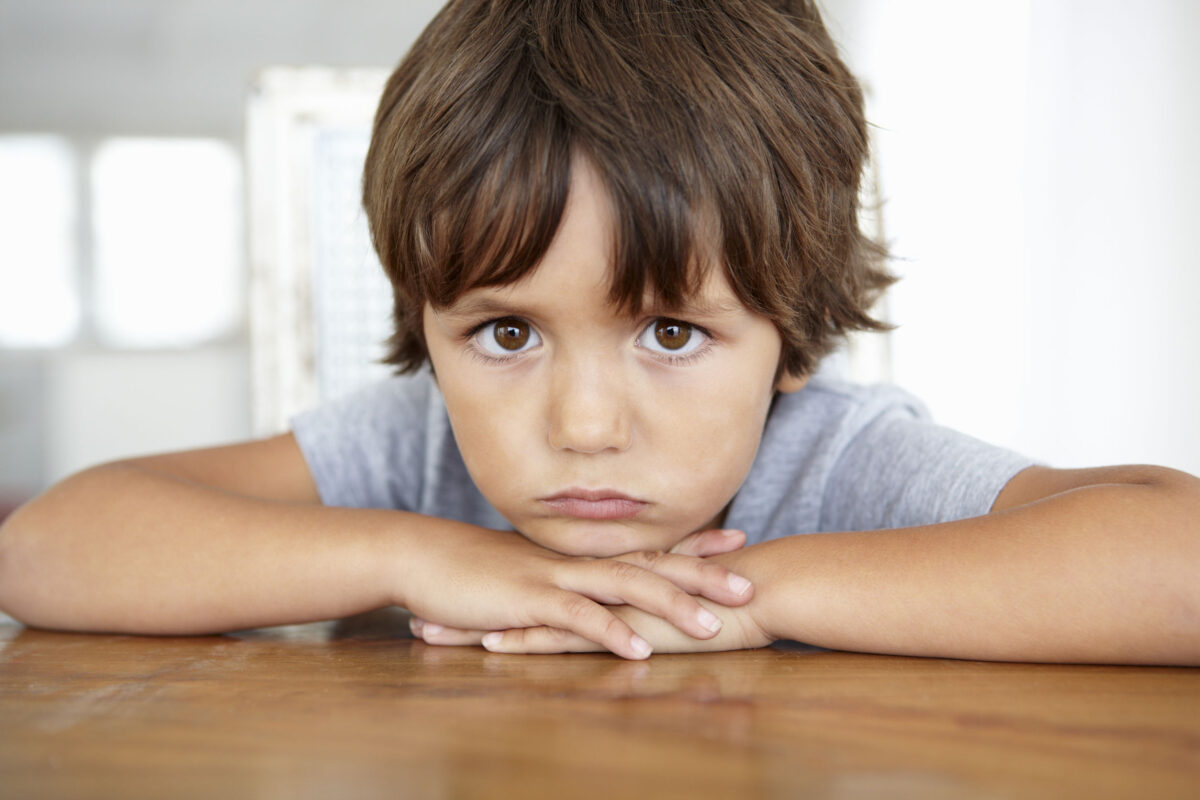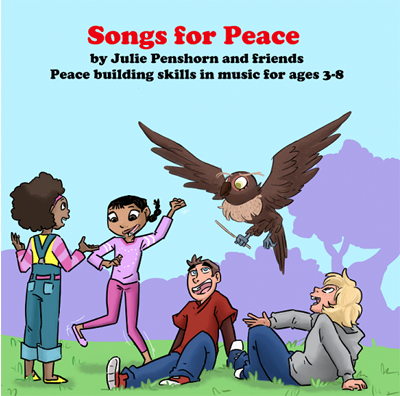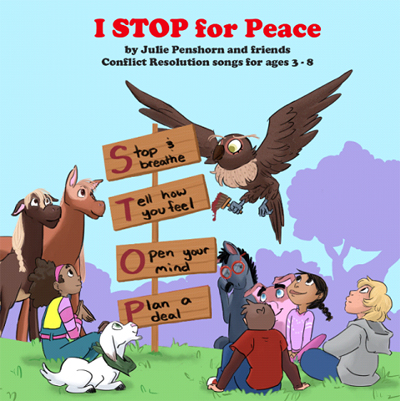Open Your Mind,
Plan a Deal and then take action
The third step in the conflict resolution process from the children’s book, The Barnyard Buddies STOP for Peace is Step O, Open your mind. This step comes after children share their feelings. At this point, opportunities and ideas readily arise. Plan a deal is what you do with all those ideas. Put a big smile on your face like the youngsters pictured, is what you do when you choose something that works for all! Become a Compassionate Rebel working for gun control is what you do if you are a high school student at Marjory Stoneman Douglas, the site of the recent, heartbreaking, school shooting!
A crisis, like a school shooting at Marjorie Stoneman Douglas High, reminds us we need children who are independent thinkers!
Crisis can lead us forward. The activism of the students in Florida reminds me of the 1960s when student activists led us to so much positive change for peace. These students’ courage, even in the face of death threats is remarkable and moving. And, when I was in the first-grade classroom last week, helping FFA teens present my book to the little ones, there was a flood of thoughts in my brain as I envisioned the beautiful, innocent six-year-olds blasted with an assault weapon.
Two things mainly came to my mind:
1) how terrifying to think of anyone hurting these children, and
2) how important it is that these children have the skills they need to make this world a more peaceful place!
Peace literacy is not an optional activity anymore
Isn’t it time we got serious about what is at stake in our country, our world? This the fragile planet of our ancestors which the Native Americans remind us to care for thinking ahead seven generations. These are the fragile children that we are charged to protect. As you continue reading this blog, I hope you see that peace literacy, including understanding and ability to use peaceful conflict resolution, is a key ingredient for their future on their planet.
Developing peace literacy includes having an open mind and skills to express yourself
As the students of Marjory Stoneman Douglas talked and cried together after the shooting, their tears showed many emotions, including anger and fear. Strong emotions like these lead people to seek ideas for a better tomorrow. They became Compassionate Rebels as their young, active minds quickly recognized that there was no antidote to their pain and suffering. The status quo wasn’t working, and they wanted change. They couldn’t go back in time and stop the shooting that killed 17 people they knew and loved, but they might be able to save someone else from their plight. They became proactive peacemakers as they took the stance together of “never again.”
Let’s solve this – “this is not difficult”
Nicole Hockley of Sandy Hook Promise, who lost her 6-year-old son in the Sandy Hook shooting five years ago, spoke recently (at a “listening session” at the White House, February 21, 2018) on the topic of school shootings. She pointed out that there are many doable steps to solving the problems around school shootings, and listed several. I expect they were the result of many brainstorming session with her group as they did the step we call O, “open your mind,” in the STOP Process. They included “more funding for mental health. . . [passing] the Stop School Violence Act,” and improving school safety and security.
The part of her presentation that was so powerful was when she said “this is not difficult. These deaths are preventable. . .” I think what she means is: these are pretty easy things to get agreement on. They aren’t weapons bans. We just need to Plan a deal that includes such solutions and reflects that we are caring for others.”
Even when problems seem insurmountable, change can happen!
After sharing our feelings, people are moved. Problems often resolve easily. Many of us certainly have been crying along with the articulate and emotional Marjory Stoneman Douglas High School students as they speak. However, whether politicians can listen and implement change with true empathy and compassion varies, because the additional factor of money, (for re-election, and keeping one’s job) is such a significant one in political decisions. Money is a relevant consideration for us too, as parents, citizens, and leaders.
But this is really not difficult! There are so many ideas that pass the criteria of Step P – Plan a deal: They are good for me, good for you, and good for the community. You could even add, good for the seventh generation.
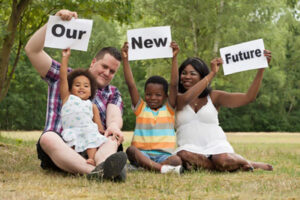
Our Shared New Future
If self-interest prevents some from making decisions that are good for others and our shared future, non-violent strategies can still effect change. Voting, for example, can make a huge difference! Putting pressure on people’s financial interests is another method. The activism of the students and several corporations to stop favoring NRA members is a terrific example.
Working directly with young children, where we are not hampered by that additional consideration, is a great joy! We can certainly say, as Nicole Hockley did, “This is not difficult!” The children are capable of solving very complicated problems.
Introducing Brainstorming is Introducing Imagining and Creativity
In a classroom or home, the “Open your mind” step offers teachers and parents an opportunity to introduce the idea of “brainstorming” to young children. This is a wonderful word since it can be so much fun! There are countless creativity exercises and brainstorming activities to help children get the idea that brainstorming is not about right and wrong, but about playing with ideas. Then they can really open their minds and become powerful peacemakers.
Step O, Open your mind is about brainstorming! Seem too complicated for your three-year-old? Keep reading! The companion music CD, I STOP for Peace makes it so easy! It has a song for Step O, Open your mind. It’s called We’re Having a Brainstorm. It connects brainstorming and rainstorming in a fun way that you can do at home or at school (see tips below). The other songs and children’s dialogues on the full CD support each step in the conflict resolution process and kids dialogues demonstrate each of the steps.
Not right or wrong, just different
When we have a conflict with any person we often find that it’s not about right versus wrong, but rather about “different.” We simply have different ideas about something. The other person isn’t “bad” and we aren’t perfect! Only after feelings have been shared in step T, Tell how you feel, do we begin to recognize that we start from common ground. Through the empathy and compassion we build in step T, we recognize that the other person is a frail human-being too! What if some of the people looking to buy assault weapons had a friend to talk to?
Problem-solving, even between adults and children, is not really about right and wrong. It’s about finding a solution that honors everyone and respects differences. That’s why Step O, “Open your mind,” works best with a large dose of empathy and compassion in the room! Without them, right and wrong have to be drilled into a child, often with very mixed results!
Children are very good at opening their hearts and minds to all sorts of possibilities and diverse opinions. Thus, “teaching” them about right and wrong is largely unnecessary. With the help of a few simple guidelines, they begin to make healthy choices on their own.
“Somewhere beyond right and wrong, there is a garden. I will meet you there.” Jalaluddin Mevlana Rumi – ولوی
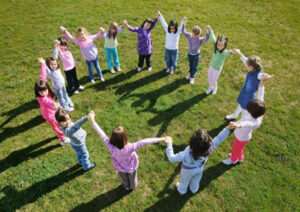
Developing classroom community
How do we role model ways to respectfully interact with others?
Children learn from our actions. Role modeling for right and wrong is witnessed. It is important. Sometimes we may forget how we role model. For example, Do we STOP and breathe when we are angry with a child. . . ask the children how they feel (step T) tell them how we feel (step T) blame them for our feelings? Do we honor and respect their ideas (step O) and involve them in (step P) planning solutions?
Sooner or later, whether we like it or not, our children grow into teens and adults! The type of foundation we helped them build for problem-solving intelligently and peacefully determines whether they spend their years rebelling or lend a positive influence to our shared future.
Consider this: In math class, children are asked to show their work. The teacher wants to know how they are thinking it through. Ask yourself, “Do I want my kid to be able to think things through? Be an independent problem-solver? Be articulate like students at Marjory Stoneman Douglas High?
When the problem becomes an opportunity for joining
The other day I was at a political caucus and even among people who were like-minded politically, heated conflict developed over how details of energy policy should read in a resolution which we were drafting. It surprised and concerned me that the hackles quickly rose! Pleased that I could enhance the conversation with a focus on areas of agreement and commonality, I shared my worry that we were bogging down and not focusing on our shared larger goals. That was the opportunity for joining in this conflict.
Many years of peacemaking and peaceful conflict resolution experience prompted me to use my peacemaking skills and not get caught up in minutia. Like anything else, these skills require practice.
We must start with young children
Skills for peaceful conflict resolution become a habit only when practiced over time. Starting young gives children years to practice! They learn to respect other points-of-view and find solutions that truly work for all involved when they learn the STOP for Peace Process.
Blowing up the lab
A point-of-view that emphases “right or wrong” suppresses possibility. It creates perfectionism and fear to try something new and make mistakes. Years ago I had a boyfriend who was a scientist. He worked at a major corporation in Minnesota where experimentation was vital to company growth, renewal, and profitmaking. He once told me he blew a wall out of his lab and the company didn’t even slap his hand. I was amazed, “Why not?” I queried.
“Because they like me to make mistakes! That’s where learning, and ultimately the success, comes from.” was his reply.
Tips for brainstorming sessions “Open your mind”
When we work with young children it’s all too easy to discount their opinions and ideas! Though we may not even understand some of their apparently nonsensical comments, we need to try to follow them enough to honor them and write something down! Often we do have a better idea than they do. It would be faster if we just solved that problem ourselves! Especially since we are always overworked and in a hurry!
But how can young children practice and make mistakes when we constantly give them our answers? They need space for their voices and ideas to be heard. If we don’t allow them to experiment, they won’t learn the limits naturally and they will end up suffering from their poor decisions. And we won’t get a chance to see how they are thinking things through and using the “open your mind” step.
Solving problems in classrooms or homes must be safe for kids so they can learn and experiment. Those places are wonderful as children’s life-laboratories!
One RULE for “Plan a deal”: Any good choice from the Open your mind step must be good for me, good for you (the other party), and good for the community.
When generating ideas with children, don’t edit. Try to gently guide without giving too many suggestions. Occasionally remind children that there are rules that must be considered when they are ready to choose an idea and “Plan a deal.”
In our work over the years at Growing Communities for Peace, we usually write down each child’s brainstormed idea. Then as a second step, we go through with the child/ren and review each idea asking: Is it good for me, good for you, and good for the community? If yes, we leave that idea on the sheet of paper or the board. in the final analysis, everyone’s point-of-view is honored and validated if it meets the simple, comprehensive rule.

The Barnyard Buddies STOP for Peace conflict resolution and anger management for kids
Problems become opportunities for learning with “The Barnyard Buddies STOP for Peace”
Opportunities to practice new problem-solving and conflict resolution techniques will arise. When something comes up, ask the children, “How would the Barnyard Buddies and Mrs. McCloud solve that?” Be sure you start by asking if anyone still needs to do Step S, STOP and breathe. If not, move into sharing feelings and so on.
The Story
In The Barnyard Buddies STOP for Peace, King (the horse) is a little oblivious! Some say he‘s like a person born into privilege who has no idea how much space he or she is occupying in the world. “Space” can be physical space, as in King’s example, or figurative “space” in the case of consuming more than one’s share of resources.
The other barnyard buddies suffer due to King’s behavior, perceived as selfishness. But, after all the animals reveal their feelings, and King tells them he’s lonely – compassion and empathy flow. After building that foundation, the buddies easily move toward problem-solving.
In step O, “Open your mind” brainstorming happens. The last step is, P, Plan a Deal. Finding a solution that works for all isn’t really an obstacle after empathy reminds conflict partners of the value of each member of their community.
It’s not solving the problem that’s difficult
When you open your mind, good ideas often abound – even around the most complicated problems. The challenge is finding the emotional space and willingness to listen with true empathy and compassion when parties talk about their feelings and needs (please read the last blog post for more on this) so a solution that works for everyone involved can be unearthed and implemented.
Tips for Brainstorming and learning to “Open your mind”
Here’s a simple creativity exercise to get you started. Pass a bracelet around the circle, or dinner table. The child holding it gets to say what it might be – there are no right or wrong answers! Role-model with, “This is a spaceship from outer-space that’s carrying many gifts to others.” Or, “This is one of the rings around Saturn (tie in with another lesson). . . This is my wedding ring. It reminds me how much I love my family.”
Whatever works for you is fine, as long as it’s a bit in-depth. The more involved the answers of the children, the more their imaginations are encouraged. Do the same thing with a pencil: “This is a rocket ship taking me into space,” etc.
Motions for children’s hands show how to “Open your mind”
Sign language is great to use for each step of the STOP Process. We will make a video soon showing each step with hand signs. Meanwhile, a fun way to show kids how to “Open your mind,” is to put a hand on top of your head and flip the fingers upward as if opening a door on top of your head. This makes it more fun as children enjoy making motions for all the steps of the process, plus it helps them internalize the skills as they gain muscle memories.
Keep an eye on the smarttools4life Youtube channel (join our mailing list to know when new videos are posted) to watch for our next video showing all the hand signs for the process. The teen mentors participating in the recent Chisago Lakes School District FFA Teen Mentor Program loved demonstrating them.
In the CD, I STOP for Peace, some of the words of “We’re Having a Brainstorm” are:
We each tell our feelings, what do we get?
I’m sad, lonely, hurt, mad, or something like that.
It really takes practice to speak from the heart.
I know you can do it! You’re so very smart.
After each feeling we have has been said,
We start getting lots of ideas in our heads.
This is brainstorming. It’s fun to do!
We use our brains and we use our hearts too.
Chorus: We’re having a brainstorm, not a rainstorm, (sounds of thunder and rain in the background)
It’s brainstorming today.
We’re having a brainstorm, not a rainstorm!
It’s brainstorming today.
Use a rainmaker to make brainstorming really fun!
If you have a rainmaker

Using a lovely wooden rainmaker with a soothing sound as you tip it up and down makes brainstorming a “rainstorming” fun time!
like this one, available on Amazon, you can really get the kids excited about the “Open your mind” step. Because we call it “brainstorming” we have a lovely auditory connection through the word used in the song, “We’re Having a Brainstorm.” Play the song from the CD, get out your rainmaker and make it extra fun!
Long, beautiful, wooden rainmakers sound just like rain. You can add a drum and have a real rainstorm for your brainstorming sessions. That makes these times really special. The plastic ones also on the Amazon page, I have not seen or heard. With a visual and auditory tool, children really look forward to problem-solving!
Adding lightning to the rainstorm when great arc-sparks come to us, can be another fun way to explore the Open your mind step. If you have some flint you can crack them together and get a small spark. That’s another visual, auditory, and hands-on learning tool for children participating in the wonderful activity of brainstorming.
If you really want to have fun with this work, add the whole CD or MP3, “I STOP for Peace,” by Julie Penshorn. The children’s dialogues and practice problem-solving are a lot of fun. They make the steps of the entire process very easy to remember.
Plan a Deal – Worthy solutions should pass this test:
After determining which ideas are good for me, good for you, and good for the community, the suggestions can be reviewed and one is chosen as the first one to try. A consensus is important. When that can’t be achieved with one solution, ask the children if they can think of ways to combine or change ideas so all will be satisfied. Sometimes you have to back up to step O or step T at this point.

I STOP for Peace teaches the STOP process with short kids’ dialogues and music
Hand Motions and celebrating
When I teach this in the classroom, I like to say, “Plan a Deal, YAY!” My hand motions are, shake my other hand (if alone – or shake the hand of a neighboring student), then flip my hands and shake them again, then raise my fist in the air and say “Yay!”
The celebration of successful, peaceful conflict resolution is an important part of generating enthusiasm for the process. Don’t make it “Oh, ho-hum, we solved a problem, that’s nice.” Make it a “Wow! You are terrific problem-solvers! Look at how you worked it out! Soon you can solve the big problems of the world, with your great thinking!”
Doesn’t the latter sentence above motivate you? Why not bring enthusiasm? Our lives may depend on it!
What we focus on expands
If you want a peaceful classroom where children are independently solving their problems, the classroom is a truly safe and caring community, and your job as a teacher is easier, spend the time necessary to create that classroom environment.
Spend the extra moments in a class meeting at the end of the day to discuss any unresolved issues and celebrate problem-solving successes — especially the independent ones. The book “The Barnyard Buddies STOP for Peace” has many activities for you to make this learning process complete. You can get it here.
Our kids are our societies’ future leaders and must be problem-solvers
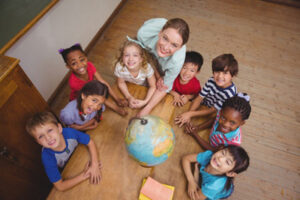
Children in a classroom are gathered around a globe learning about others.
Given the chance to let their wonderful, liberated minds address a problem, children’s solutions will amaze. Unhampered by money, unfettered by “right and wrong,” children often exceed the ability of adults to solve problems.
As parents and teachers, we can lay the foundation for them to have a long history of problem-solving in a community. They can learn ways from you to find win-win solutions that will impact their fate and perhaps the fate of the entire planet. Your work together with children is SO important! Thank you for your contribution to society as you care for and guide your/our children!
To download the wonderful coloring page at the top of the article, simply go here, scroll down a little, and click on the coloring page.

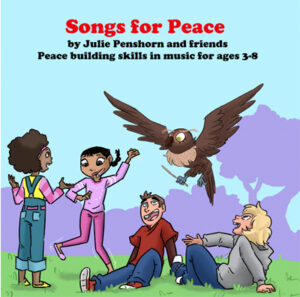

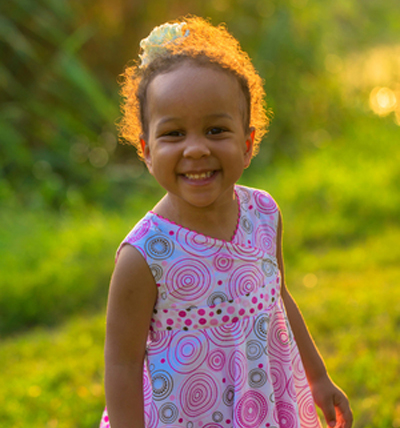


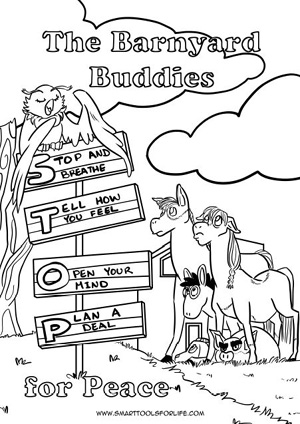
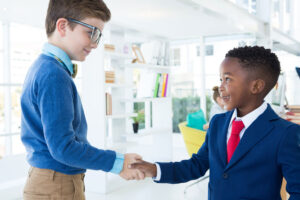





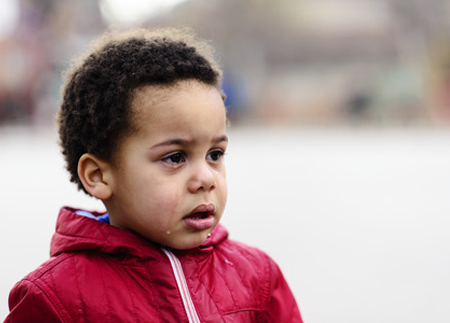
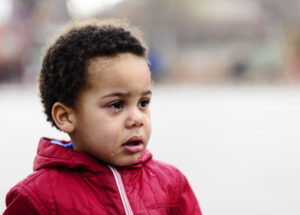




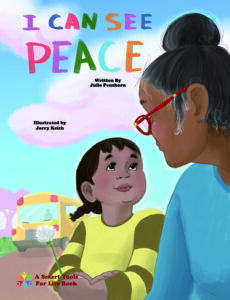
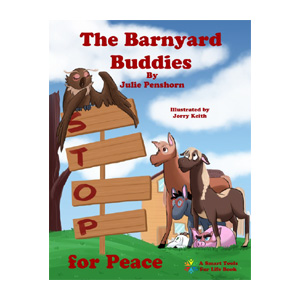






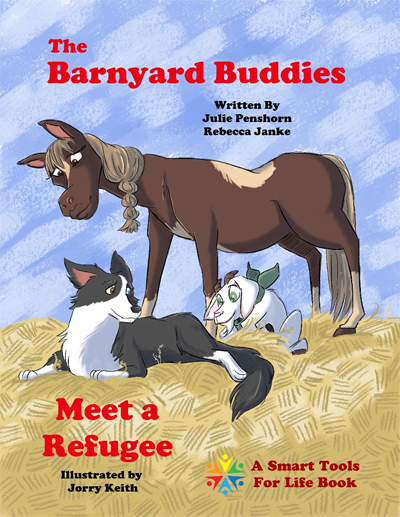
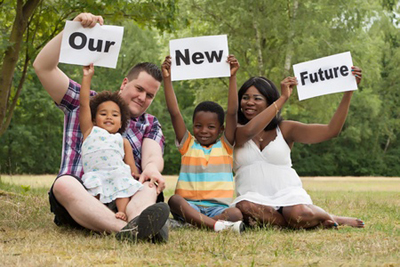
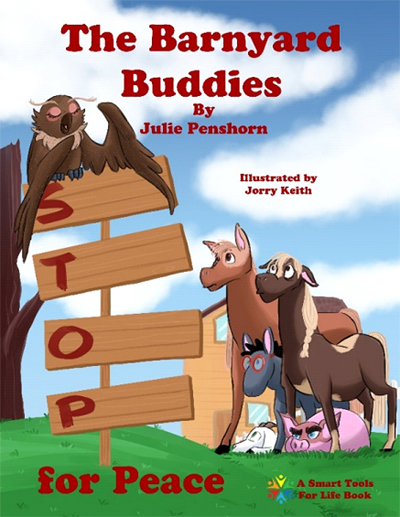 This link is to Barnes and Noble. You can also find it on
This link is to Barnes and Noble. You can also find it on 